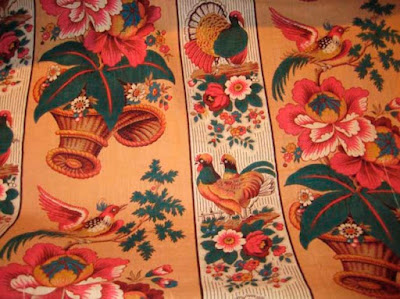From the Cooper-Hewitt collection.
Wacky bird---a peacock crossed with a cockatoo?
The caption indicates the print was made about 1860 for the Portuguese.
I've been sorting photos of chintzes of various types and I've got a small and strange category: Portuguese Prints. See yesterday's post for more pictures.
Yesterday I showed a turkey stripe, attributed to Portugal by two museums.
The Houston Museum of Fine Arts has
the same print in their Bayou Bend Collection but
without any Portuguese attribution. The famous
Ima Hogg collected the objects for that house.
Similar prints probably from curtains in the Bayou Bend collection.
Ms. Hogg collected many furnishing fabrics. The captions do not indicate a source or specific date but these stripes seem to be in the same style.
But were the striped chintzes printed by the Portuguese or printed for the Portuguese?
The Cooper-Hewitt has a wholecloth cotton quilt with a wool fringe
said to have originated in Portugal.
This gives us an idea of the scale of this stripe. If the bedcover is 84 inches
across a pair of light and dark stripes is about 16 inches here.
Print from the Boston Museum of Fine Arts,
attributed to Portugal.
The bird is being held by a person in oriental dress.
Dogs are always good (although not common in these stripes.)
The scale is smaller here I assume.
Note that double handled, footed vase.
Were the striped chintzes printed by the Portuguese or printed for the Portuguese? I think the answer here depends on the time period.
Through my searching for words like Portugal/Portuguese/Chintz/Cotton/Stripe, etc.
I found for sale on Etsy "Portuguese chintz fabric with traditional design."
Contemporary Portuguese prints
Two stripes: bird in one, flowers in the other.
No birds but you get the picture.
I speak not one word of Portuguese but here is what I have figured out:
A perfect description of the Portuguese prints I've been looking at.
A wider definition in Portugal seems to mean any floral stripe.
Chita is derived from the Indian/Sanskrit word Chitra from which the English word chintz also comes. The design ideas also originated in India centuries ago.
Alcobaça turkeys
A hotel there, The Real Abadia Congress, shows a photo of a familiar Portuguese Print on their website, using Chitas to show some local culture. Here's their definition and history:
"Chitas are a cotton cloth...varied decoration which contains birds, trees, flowers, fruits, oriental and european human figures, cornucopias, amphorae and all the fauna of India and Persia, stylized in arabesque or edges.... the decorative motifs are arranged vertically to allow it´s use on the fabric of bedspreads, being this one of the most common use in Alcobaça.
In the sixteenth century, labored in Alcobaça many looms that sold their production between the town and Lisbon. The historical facts do not fully prove the existence of chita´s manufacture in Alcobaça, but the collective memory claims it to be. The frequency of use of chita in every household from humblest to the most affluent during generations made it part of our collective identity and therefore our culture."
I like that line "but the collective memory claims it to be."
Charleston Museum Collection
Did Kate H. Tupper of Charleston, South Carolina
use a Chita de Alcobaça in her border in 1850?
PS: An amphora is a double-handled, footed vase derived from classical Greek pottery style.
Di Ford's repro line Bally Hall has amphorae in the stripes.
More history in English here:
This Etsy shop sometimes has Chita de Alcobaça in stock.
Contemporary Chita de Alcobaça
I found a 1950s version of the wacky bird at the top.
It's called Les Perroquets (The Parrots) from Prelle et Cie in France.
You can buy a few yards from this Etsy seller:
You can tell it's recent by the selvage.
UPDATE: Francoise gave us some links for chitas.
Click here and scroll down to the bottom:
More on Portuguese Prints tomorrow.





















These prints remind me of wallpaper.
ReplyDeleteThis is so fascinating. My grandmother had a sewing basket lined with a fabric that looks like the one with the turkeys. My great great grandfather came to New England from the island of Graciosa in the Azores. Now I will see if I can track down that basket. My father had a very large family, but hopefully one of the cousins is in charge of it now. Thanks for another great post.
ReplyDeletehttps://retrosaria.rosapomar.com/collections/tecidos-portugueses-portuguese-fabrics/products/belmonte-azul-claro
ReplyDeleteThose fabrics remind me so much of the Portuguese fabrics you can still buy (I did!) at this shop in Lisboa.
https://retrosaria.rosapomar.com/collections/tecidos-portugueses-portuguese-fabrics/products/viana-azul
ReplyDeletehttps://retrosaria.rosapomar.com/collections/tecidos-portugueses-portuguese-fabrics/products/chita-de-alcobaca-azul
Thanks for the links Francoise
ReplyDeleteLOVE those chintz stripes! One year at Quilt Festival in Houston, there was an exhibit of the Patchwork Divas and one of the quilts had a turkey stripe reproduction in it. I fell in love with it and sure wished I had found some of it when it came out.
ReplyDeleteYour posts on the history of fabric are so fascinating to me! So fun to learn about how things come about or perhaps where they might have originated. I was wondering if I could chat with you briefly sometime about a vintage quilt top that we have in our possession. We think my hunsband's great grandmother may have made it but don't know for sure. My intent is to finish it one day. I can send you info about it if you want to take a look at it. I have never seen another made in this particular pattern before but am hoping you may have. We found a very similar pattern in your book but it isn't exactly alike. Thanks again for all the great information you provide on your blog!
ReplyDeleteWacky Bird will be forever linked with Barbara Brackman!!!
ReplyDeleteLes Perroquets (The Parrots) from Prelle et Cie in France Is available for sale on eBay. https://www.ebay.com/itm/276818010614?mkcid=16&mkevt=1&mkrid=711-127632-2357-0&ssspo=SA3ZO_EpQj2&sssrc=4429486&ssuid=SA3ZO_EpQj2&var=&widget_ver=artemis&media=COPY
ReplyDelete